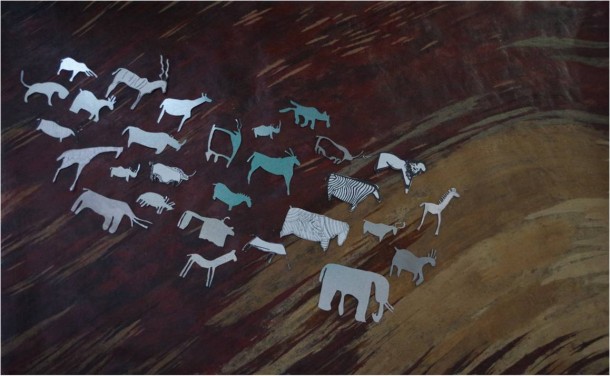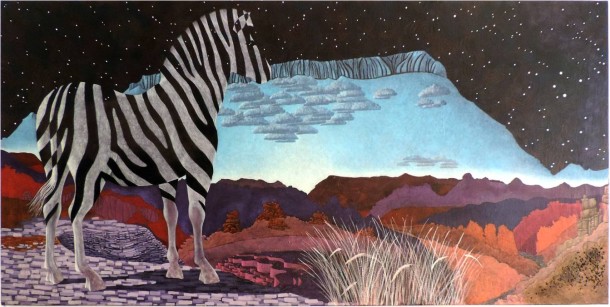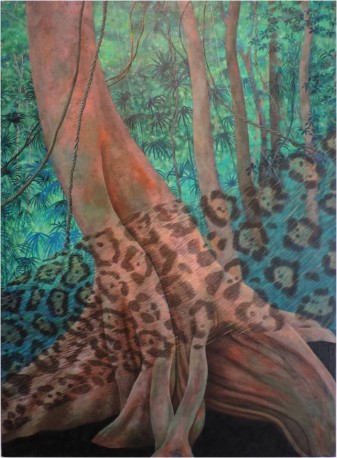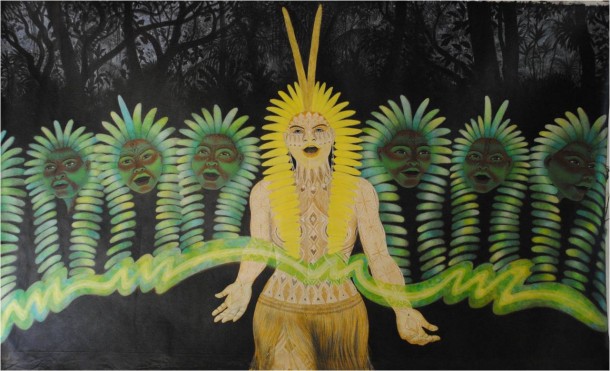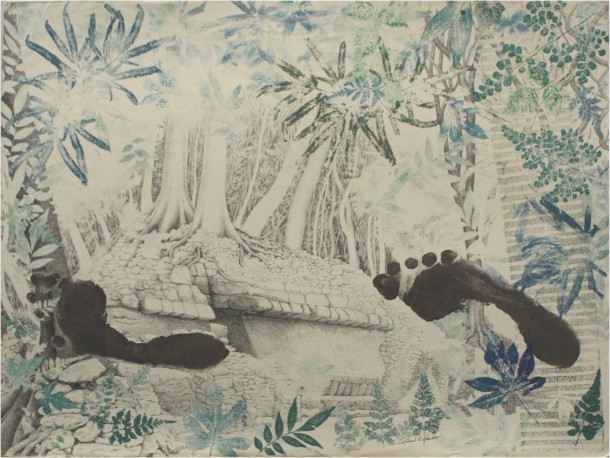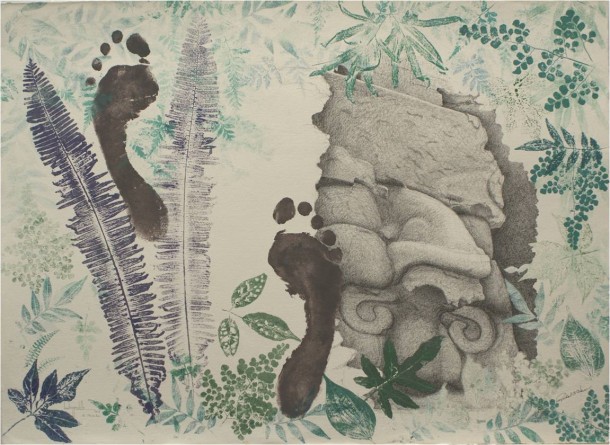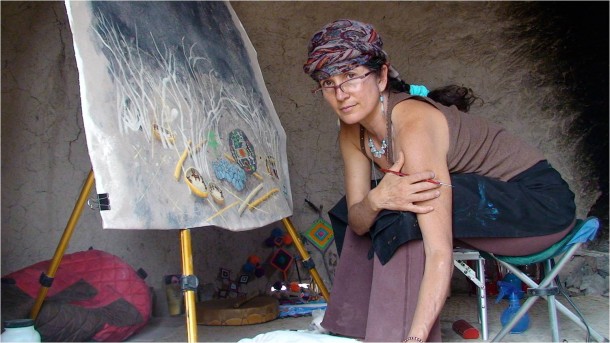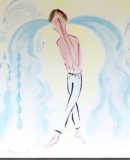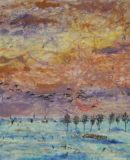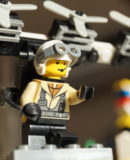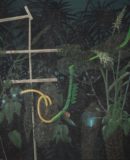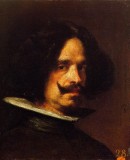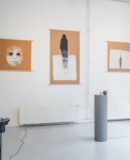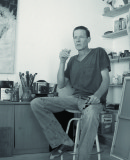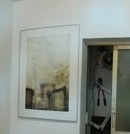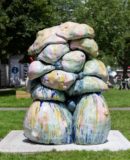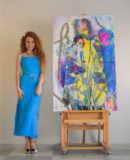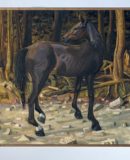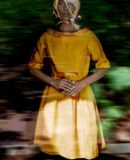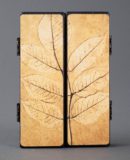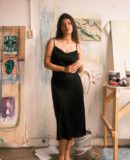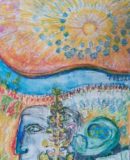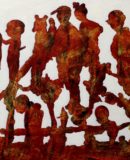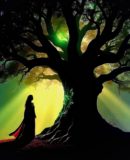World Fine Art Professionals and their Key-Pieces, 42 - beatrizpadilla
World Fine Art Professionals and their Key-Pieces, 42 – beatrizpadilla
I saw beatrizpadilla’s paintings hanging at the Mexican Embassy in The Hague: large colourful paintings about nature in Middle America, Latin America and Africa. In the corridor, ‘printpaintings’ made of the Mayan jungle in Mexico and Guatemala featured the footprints of noteworthy characters.
beatrizpadilla is an artist in the first place, but a nature activist as well. Maybe sometimes the latter predominates, as I noticed when I was talking with her in the Japanese Tea Pavillion at the Clingendael estate in The Hague. Her man, Emilio Arias, also an artist, listened while making drawings. The previous evening, the Ambassador inaugurated her exposition. Many people turned up, among them Princess Margarita, daughter of Princess Irene. One of the paintings ‘Bergplaas’, Princess Irene’s Nature Reserve in South Africa, was at a prominent place in the exposition and Margarita very much wanted to see the work.
Wilderness
Wilderness is her theme, she says. beatrizpadilla: ‘No other theme is worth my energy, my life, my resources. I feel very fortunate to work in wild nature portraying the world’s last stretches of large, unspoiled natural spaces. If it wasn’t for the benefit of our highly threatened planet, I could not grant myself the luxury of being a wilderness painter.’
Her deepest calling is to protect nature and she chose art as her strategy. ‘Mine is art on a mission, not art for the sake of art. To me, wilderness is what is most amazing about our planet: the result of millions of years of evolution with incredible forms of adaptation, exquisite beauty and astonishing intelligence, all of it essential for sustaining Life on Earth.’
Mexico’s Water Forest
Mexico’s Water Forest (Bosque de Agua) is her own backyard, an area of 250.000 hectares. She was born in Mexico City but now – if she isn’t somewhere all over the world – she lives in Cuernavaca, as does her family. ‘It is this forest that sustained me, giving water to my family, my community, to three large cities and their surrounding towns.’ One fifth of the population of Mexico lives in this region, surrounded by high mountains and volcanoes. There used to be a big lake here. It took the Spaniards 200 years to drain it, to get rid of mosquitoes. But the lake is still there, beneath the city. Over-exploitation of this water table is causing Mexico City to sink at an average rate of 10 cm per year (12 meters in the last 100 years).
On her laptop beatrizpadilla shows me her Water Forest painting, topped by a cloud of urban sprawl about to rain on the hills and valleys. The Aztecs lived here. For many centuries it has been the power centre of Mexico. There are many small roads crossing this forest. Now the government wants to build a highway right through what is the forest’s largest water-catching closed watershed. Rainwater stays here, it doesn’t run off to the oceans. ‘There are places where the water begins to flow in circles and is then sucked up through the soil.’ If we lose this forest, central Mexico would face a major water crisis, thereby affecting all of Mexico.
Bosque de Agua
To protect the forest, she and her friend Fernando Jaramillo started a Think Tank and gathered experts from various government layers, universities, NGO’s, professionals in the field of urban development and environment, conservationists and, of course, local inhabitants. A series of Round Tables was held. They recruited a seasoned conservationist, Jürgen Hoth, who has achieved many things, among them getting seven governors to officially agree that Mexico’s Water Forest is of national strategic importance. beatrizpadilla: ‘Jürgen proved to be such a good networker and organizer, that I could safely back out and return to the easel.’
From solar racecars to dead-ends
As a teenager, beatrizpadilla strongly felt the call of art. She took a few lessons here and there, but most things she found out on her own. She felt an equally strong calling to be an environmentalist. Whilst painting at home she sensed that she was missing much of life. As her alarm grew about environmental degradation, she decided to put the artist aside and give her energy to the environment, 100%. She founded and lead several projects, such as Mexico’s first transcontinental solar racecar, yearly intercollegiate electric vehicle racing championships in Mexico and Guatemala, Mexico’s Advanced Battery Consortium. beatrizpadilla: ‘I am not technically-minded at all, but I am quite a good networker. I was born under the sign of Saggitarius, ascendent Taurus. The Sag dreams big, Taurus makes things happen.’ But, as the movie title hints, “Who killed the electric car?”, thirteen years of efforts came to an abrupt end when the German advanced battery company she was promoting went bankrupt.
Gorillas
That was tough on her calling to build a dream. She took refuge on painting and made a radical choice: to paint only wilderness. It was the year 2005. She began traveling the world to paint deep in savannahs, desserts, rainforests. A hammock, a tent, a mosquito net, the easel was there, as were brushes, acrylics, canvas rolled-up in tubes, all neatly going through Namibia, Botswana, Tierra del Fuego, Chilean fjords, the Amazon basin, the Mesoamerican Reef, the Wirikuta Desert and ongoing… In 2008, at Gabon’s Loango National Park, she painted her gorilla family, which I saw at the exhibition. She was filled with self-doubt at the time. beatrizpadilla: ‘A voice inside me sharply stopped all self-deprecating thoughts: It does not matter if the world does not believe in me. The one single person that must not loose faith in myself is me. All I must do is do my best.’ Now these gorillas are, she believes, one of her best paintings. ‘Every time my father saw it, he would say: that is a very handsome Gorilla. He passed away while I was finishing the painting. I dedicated this canvas to him. His name is on the bottom-left corner.’
The contours of the mountains
She still faces doubts when painting. ‘There is a conflict. When I am ready to start painting a wild place, its beauty is breath-taking. Part of me wants to honour the beauty. Another voice says: art is not about beauty anymore. In France I got the comment “Why isn’t there some distortion?” I too would like my paintings to be more playful. It is a quest. I do not copy what I see. I do re-interpret colours, but am mesmerized by the sublime beauty of shapes and the niches that frame them. It is sheer delight to follow their lines as I build a composition: it puts me in touch with the exquisite magnificence of nature’s details. The Bergplaas painting, for example, on Princess Irene’s Nature Reserve, merges five landscapes into one, as well as day and night. Yet the contours of the mountains are fairly exact: I thoroughly enjoyed tracing them.’
50% of the proceeds from the sale of her paintings goes to the Fundación Biósfera del Anáhuac to preserve Mexico’s Water Forest, or to FARES Foundation to preserve the Mayan jungle in Guatemala. An additional 5% goes to The WILD Foundation, for international conservation projects. beatrizpadilla: ‘The project is tough because I always end up carrying too many things as I travel. Although I have a non-linear mind, I am really good with logistics. Somehow I have already managed to make 29 expeditions a reality. Despite all the toil, this art for wilderness project is deeply rewarding.’
http://www.beatrizpadilla.org/
http://www.wild.org/where-we-work/wildlands-conservation-painting-expedition/
http://ifthenisnow.nl/nl/verhalen/world-fine-art-professionals-and-their-key-pieces-42-beatrizpadilla
Disclaimer: The views, opinions and positions expressed within this guest article are those of the author Walter van Teeffelen alone and do not represent those of the Marbella Marbella website. The accuracy, completeness and validity of any statements made within this article are not guaranteed. We accept no liability for any errors, omissions or representations. The copyright of this content belongs to Walter van Teeffelen and any liability with regards to infringement of intellectual property rights remains with the author.

